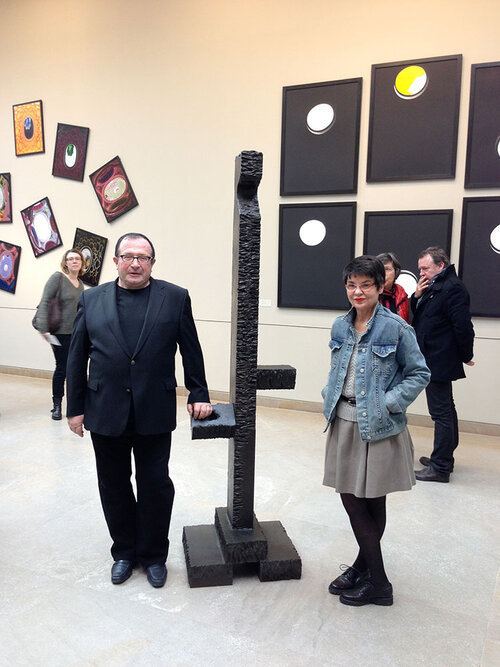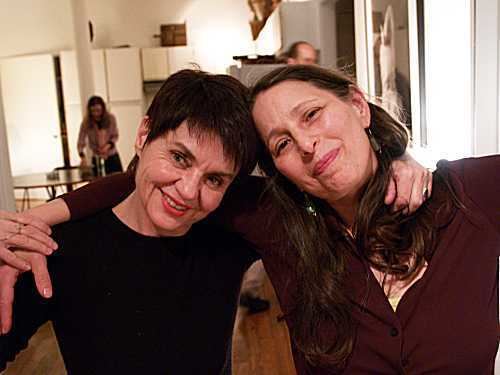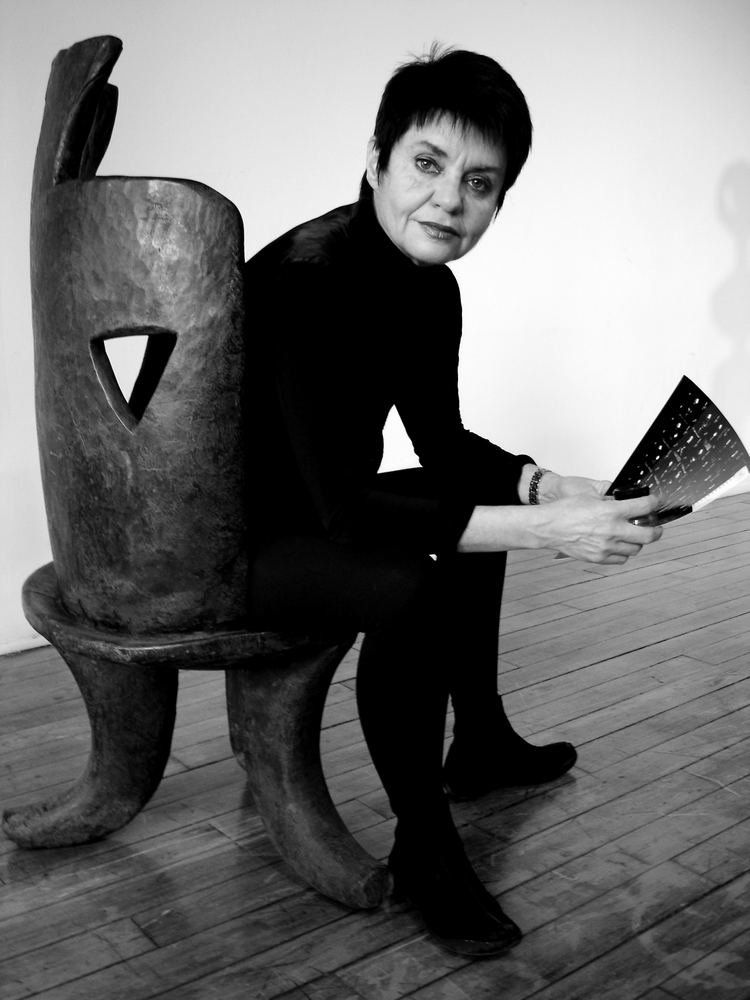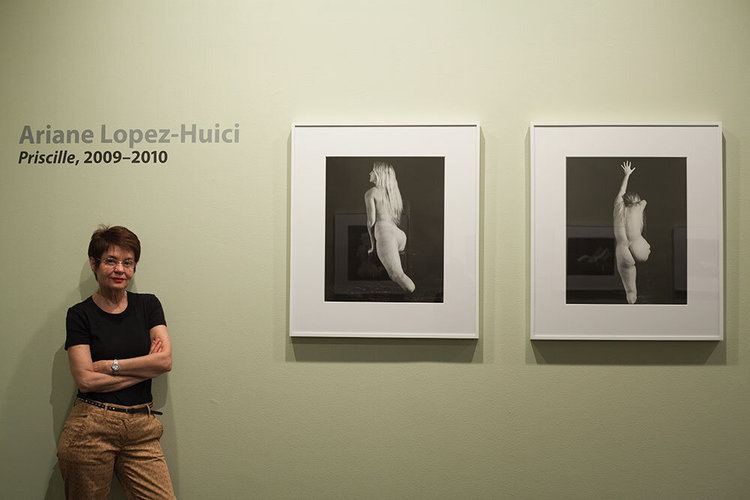Nationality French Name Ariane Lopez-Huici | Role Photographer Known for Photography | |
 | ||
Born August 5, 1945 ( 1945-08-05 ) France | ||
Ariane Lopez-Huici (born August 5, 1945) is a photographer living between New York and Paris. Her work has been successfully presented internationally in institutions - Instituto Valenciano de Arte Moderno, Spain, Musee de Grenoble, France, PS1-Moma, USA, French Institute New York, USA, among many others - as well as galleries - AC Project room, NY, Galerie Franck, Paris -. She has received a strong critical interest from prominent art historians and writers, such as Arthur Danto, Edmund White, Yannick Haenel, Julia Kristeva and Carter Ratcliff.
Contents
- Early Years
- Statuary and abstraction
- The model an ongoing revelation
- Solo Exhibitions
- Group Exhibitions
- Collections
- Catalogues
- Articles
- Film
- References

Lopez-Huici’s work is focused on the human body, constantly transgressing conventional canons of beauty. To accentuate the shadowy areas of the human adventure, she uses black and white photography marked with a pronounced grain and deep blacks. Her series Aviva, Dalila, and Holly show her passion for Rubenesque bodies. Her African series Adama & Omar and Kenekoubo Ogoïre reveal her interest for any kind of physical and sensual expression. The series Rebelles and Triumph deal with a group of voluptuous women asserting their majesty. Her series Priscille/Hecate (2009–2011), nude portraits of a handicapped model, affirms, in the tradition of Rodin, the true beauty and personality of the fragmented body. After photographing the naked body for many years, it was an unusual challenge to work with Shani Ha (2013-2016) and her wearable textile sculptures. Her images, as art critic David Cohen puts it, “convey a sense of the body as lived-in, actual and present.” Lopez-Huici, as Francis Marmande says “illuminates the model, gives her the strength to transgress what we see or what we do not see.”

Connected to the incredible rich world of the free jazz improvisation, she records in depth many of the most talented musicians, publishing for example the series The flying hands of Cecil Taylor.

Early Years

Ariane Lopez-Huici is born in Biarritz, France, in 1945 to Eugenio Lopez-Huici, a Basque-Chilean, and Evelyne Belly from Lorraine. Her great-aunt Eugenia Errázuriz was a patron of the arts, a friend of Stravinsky and Picasso, and the subject of a well-known portrait and series of drawings by Picasso. In 1970, after finishing art school in France and Italy Lopez-Huici becomes the assistant to Brazilian filmmaker Nelson Pereira dos Santos, widely regarded as the father of Brazil’s Cinema Novo. At his side she learns lighting and photographic techniques. During these years, she also develops a long-term attachment to avant-garde cinema and all forms of artistic improvisation.
Statuary and abstraction

She marries sculptor Alain Kirili in 1977. That same year, she has her first one-woman exhibition at Dartmouth College (New Hampshire). On her second trip to India in 1979, she visits and photographs the famous erotic temple of Khajuraho, creating the series Indian Ecstasy. The following year, she settles with Kirili into a loft on White Street in Tribeca, New York. At P.S.1 in New York, in 1983, she exhibits a series of photographs taken in Istanbul, entitled The Tombs of Suleiman the Magnificent. A couple of years later, in 1989, she creates the series In Abstracto.
The model : an ongoing revelation

She meets the dancer Daniel D. in 1989. The latter will model for Solo Absolu, one of her most striking series, where she photographs a man masturbating. The following year, she participates in the group-show Fragments, Parts, Wholes : The body and culture at White Columns, New York, curated by Saul Ostrow, on the theme of the body, where she presents male eroticism. Following this exhibition, the critic Jeanne Siegel writes an article about male sexuality seen by women artists and particularly explores Lopez-Huici’s involvement in her practice as a photographer : “The experience approaches the cinematic, particularly when a number of single frames are seen together. Her participation, her watching while recording, is undoubtedly an erotic experience. She is an accomplice in an activity that is a fulfillment of desire.” Solo Absolu, the series on male masturbation, is exhibited in 1994 at the AC Project Room Gallery. In conjunction with this show, “A Conversation Between Julia Kristeva and Ariane Lopez-Huici” is published, where the two artists discuss among other matters what it means to be in a couple with another artist and the photographer’s relationship to sexuality. To celebrate her fiftieth birthday and in solidarity with her models, Lopez-Huici places herself before the camera, dancing naked in the 20 minutes film entitled TOAK- 1995.
In 1999, she exhibits for the first time in Paris her Aviva series at the Galerie Frank. This series is crucial in Lopez-Huici’s search for the transgressive body. Aviva, a beautiful large woman reclines or sits proudly on a bed. Arthur Danto writes in the catalogue for this exhibition that “the paraphernalia underscores Aviva's identity as a model, someone who is there to be depicted, and not to represent anything ulterior. The poses too belong to the repertory of studio poses : she is not shown doing anything but pose, which of course goes with her nudity” and further “The photographistic setting is intended as a guarantor of the reality the photographs show : Aviva is the way we see her.”
During this show, Lopez-Huici encounters Dalila Khatir, a very important future model in her work.
The following year, at FIAC, in Paris, Gallery Frank exhibits a collection of photographs of her favorite models: Aviva, Dalila, Mother and Son, Femme à la Toilette, and a new model from New York, Bill Shannon, a paralyzed hip-hop dancer.
In 2003, she travels at length in West Africa, photographing the African wrestlers Adama and Omar in Dakar, the Master of Ceremonies Keneboubo Ogoïre in Mali, and Les Élégantes from Saint Louis in Sénégal. These series inspire the following comment by her friend, the critic Edmund White in an essay about her work : “She is in search of images, not the tourist’s snapshots (her eye is not that passive) but rather those pictures that contest her own being or confirm her darkest suspicions or brightest hopes about human nature.” The series of African wrestlers is presented later in 2005 at the Bowery Poetry Club in New York. In 2004 she has two one-person exhibitions in museums, one at the Musée de Grenoble, France, and one at IVAM (Institut Valencià d’Art Modern), in Spain. Carter Ratcliff and Edmund White write for the respective catalogues. At the New York Studio School in 2007, Lopez-Huici shows a selection of her nudes, especially her most recent group series Rebelles and Triumph, with a catalogue written by Carter Ratcliff. The latter captures something very accurate about Lopez-Huici and her work when he says : “ She is a photographer She is not afraid of flesh She is not in love with pure form. Nor with impure form, for she does not believe in simple dichotomies.”
In 2008, the photographer and multimedia artist Marilia Destot makes the “photographic” film The Body Close Up, a retrospective documentary which reveals the evolution and artistic challenges of Lopez-Huici’s photography from abstract to figurative art to a jubilant celebration of the body. The film mixes the artist's photography and her verbal commentary with musical quotes from writers and musicians close to her work. It also shows for the first time, the intimacy of a session in the studio with the artist and her models. This film gets its first screening at the Maison Française of New York University the same year.
Lopez-Huici exhibits in 2010 her series with a handicapped model, Priscille, in the joint exhibition Ariane Lopez-Huici and Marilia Destot : The Fragmented Body, at the French Institute Alliance Française in New York. Guy Sorman writes in the text “Free Bodies” that accompanies the show, “Ariane’s photos reveal to us, in all indiscretion, the degree to which we live in an era that represses bodies, even in the West, even as it pretends to liberate them” and she “authorizes us to gaze at Priscille, and to find her beautiful.”
In 2012 she presents, at the New York University in France, a series of photographs she made with two important models, Dalila and Priscille. In an insightful text on Lopez-Huici’s work written by the writer Yannick Haenel for the exhibition, he notes about her models : “Look at these women : they tear through the screen of convention, they are just not "right," as one says in the U.S. Their solitude is a splendid combat : that of bodies that see themselves rising up, that breathe forward, smiling with their shoulders. Their backs breathe, their hair is thinking. Breathing and thinking ground a freedom for each irreducible body,” and specifically about Priscille : “For Priscille is not excluded from her body : everything in her proclaims this gracefully. Her body is calmly that of a warrior : it is desirable. It makes me want to say, transforming Rimbaud’s discovery, the body is an other.” He concludes “To take pleasure [jouir] is to discover the attitude, the gesture, the method that disenchants existence; every instant that breaks with our programmed captivity becomes a victory : and even if the accidents of life have damaged your body, triumph remains possible, frightening, and sublime; it is affirmed here, in the black and white lightning flashes of Ariane Lopez-Huici.”
In 2014, Ariane Lopez-Huici exhibits in Parcours Croisés a duo with Alain Kirili at the Musée des Beaux-Arts de Caen in France. It is the first time they show together revealing a lifetime commitment of a shared artistic life.
Ultimately, as the artist put it herself during a long dialogue with her friend, the philosopher Paul Audi, “In every one of my photographs it isn’t the human being that is stripped bare but the humanity of the human being. ... It’s that humanity (...) which calls to me and stimulates me.”
Solo Exhibitions
Group Exhibitions
Collections
Catalogues
Articles
Carter Ratcliff, In Conversation Carter Ratcliff with Ariane Lopez-Huici, The Brooklyn Rail, September 2016• Carter Ratcliff,Society as Cosmos, The Brooklyn Rail, May 2014• Paul-Louis Rinuy, "L'imperfection est la Cime", Narthex, March 2014• Aileen Jacobson, "Perceptions of Beauty and Their Cost", The New York Times, Sunday March 9. 2014• Edmund White, "Lavished in Kindness: Ariane Lopez-Huici Photographs Priscille", Artcritical, April 23, 2013 • Ariane Lopez–Huici and Alain Kirili, Ariane Lopez–Huici et ses modèles, Art & (online magazine) nº1, dec 11/Jan-Feb 2012, p 72–87• Valérie DI CHIAPPARI , Interview and portfolio "La différence m’attire par tout ce qu’elle représente de résistance aux normes sociales." , Faire Face Magazine, France, June 2010• Deborah Garwood, "Film Review : Ariane Lopez-Huici: The Body Close Up. A Film by Marilia Destot", ArtCritical, June 2009• Ann Landi, “Ariane Lopez-Huici, New York Studio School”, ArtNews, April 2008, p 26• Lucio Pozzi, “ La levità dell’opulenza”, Il Giornale dell’Arte n°274, March 2008, p 38• Joe Fyfe, "Ariane Lopez-Huici : Photography, at New York Studio School", Artcritical, January 2008• Alain Kirili & Ariane Lopez-Huici , " Afrique", Fusées 9, October 2005, pp 138-155• Brooks Adams, “The Camera and the Flesh”, Art in America n 2, février 2005, pp. 59-63 France Huser, “Photographe de la transgression”, L’Officiel n 884, avril 2004, pp 80• FV, “De corps en accords”, Le Dauphiné libéré, 26 mars 2004• Catherine Firmin-Didot, “Divers canons de beauté”, Télérama Hors-série Gauguin, octobre 2003, pp 96-97• Francis Marmande, "Des secrets entre ombre et lumière", Le Monde, 22 octobre 2002• Linda Nochlin, , "Off beat and naked", www.artnet.com, 8 novembre 1999• Francis Marmande," Ariane lopez-Huici, Aviva Stone et la beauté de la vérité", Le Monde 3-4 octobre 1999• France Huser, "L’art du grotesque, Peter Saul, James Ensor, Ariane lopez-Huici", L’officiel, oct 1999, pp 158-162• Michel Nuridsany," Ariane Lopez-Huici : Le poids des photos", Le Figaro, 21 septembre 1999• Nadine De Koenigswarter "Ariane Lopez-Huici-Galerie Frank", Le journal des expositions, no 66, sept 1999• Lilly Wei, "Ariane Lopez-Huici and Michel Auder at AC Project room", Art in America, October 1996• New observation 112. pp.9, Fall 1996• Barry Schwabsky,"Ariane Lopez-Huici, at AC Project room", artforum, May 1996, p.105• Roberta Smith, The NewYork Times, feb 1996• Linda Yablonsky,Time Out, New York, jan 17-24, 1996, p.28• Francis Marmande, Le Monde, 22 aout 1995, p.17• Francis Marmande, “La vie du jazz”, jazz magazine, oct 1995, p.30• Susan Hapgood, "Ariane Lopez-Huici at AC project room", art in America, nov. 1994• James Sturz, “The Stones of Venice”, Forward, may 27, 1994• Carin Smilk, “Photos represent a testimony of Italian-jewish life”,Manhattan jewish sentinel, April 27, 1994• Jeanne Siegel, “Unveiling the male body”, Art Press, sept 1993.pp 25-29• Anne Rochette&Wade Saunders “Ariane Lopez-Huici at Gerard Delsol & Laurent Innocenzi”, art in America, July 1993, pp 111-112 Claire Bernstein, “Ariane Lopez-Huici”, Art Press, May 1992• Frederic Altman, “Ariane Lopez-Huici-La luniere du noir”, Nice-Matin, march 1, 1992• Bomb Magazine, Spring 1991, pp 42-43• Jeanne Siegel, ”Erotic/fragment : Ariane Lopez-Huici’s tactile photographs”, arts Magazine, November 1990• Gretchen Faust, “Grossman, Lopez-Huici, Rosemberg, Schneeman, Semmel”, Arts Magazine, May 1990• Joan Pachner ,Ariane Lopez-Huici”, New Observations, #50, September 1987• Donald Kuspit, “Ariane Lopez-Huici at P.S.1’, Art in America, 1982•
